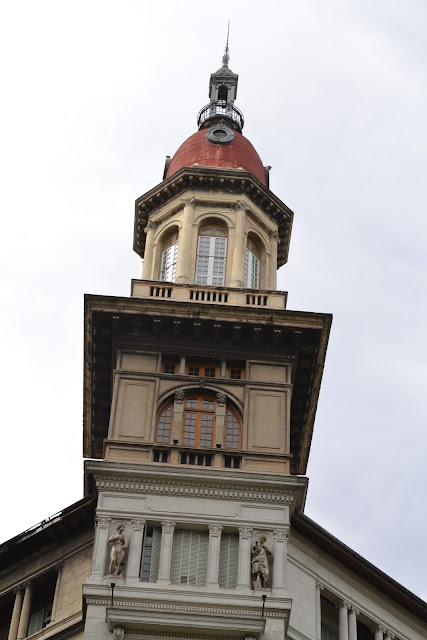El Palacio de las Aguas
Corrientes conocido hoy en día como el Edificio de Aguas Argentinas, construido
entre 1887 y 1894, es a mí entender y opinión uno de los ejemplos más hermosos
de arquitectura Europea en la ciudad de Buenos Aires. Fue construida para
alojar los tanques de agua corriente y abastecer a la ciudad y solucionar
los crecientes problemas de salubridad que traía aparejado el exponencial
crecimiento que vivía la ciudad para fines del Siglo XIX.
Las obras estuvieron
a cargo de un Ingeniero Sueco y un arquitecto Noruego. Carlos Nystonner y Olaf
Boye, respectivamente. La estructura interna cuenta con 12 tanques de agua, que
combinados pueden llegar a almacenar 72 millones de litros de agua. Se debieron
importar 170.000 piezas de cerámica y alrededor de 130.000 ladrillos esmaltados,
provenientes de Bélgica e Inglaterra para completar la fachada del edificio.
Estos llegaron en cajas enumeradas, lo que permitió la rápida construcción, al
mejor estilo de las casa pre fabricadas de hoy en día.
Pensar que el único objetivo de
la construcción de tan fastuosa fachada era embellecer y/o ocultar los tanques
abastecedores de agua. Evidentemente una excentricidad que solamente la llamada
Generación del 80 pudo darse el lujo de llevar a cabo. Sin embargo, es
indudable el valor arquitectónico y urbanístico del edificio.
The “Palacio de las Aguas Corrientes”, better
known nowadays as the” Edificio de Aguas Argetinas”, was built between the
years 1887 and 1894, and constitutes one of the most magnificent examples of
European architecture in the city of Buenos Aires. It was built to hold within
its walls the water tanks required to supply running water to the city and alleviate
the growing sanitation issues caused by the exponential population growth of Buenos
Aires by the end of the Nineteenth Century.
Construction of the building was commissioned
to a Swedish engineer and a Norwegian architect. Carlos Nystonner and Olaf
Boye, respectively. The internal structure has 12 water tanks, that combined,
can store up to 72 million litres of water. The construction required importing
170,000 ceramic pieces and 130,000 glossed bricks, from Belgium and the United
Kingdom, in order to finish off the outer structure. These arrived in numbered
boxes, which allowed workers to quickly put the pieces together.
And to think that the sole objective of this
building was to hide and/or embellish the water tanks required for fresh water provision
for the city. This was an eccentricity which only the so called “Generation of
the 80´s” (1880´s) was able to carry out. Regardless of this, its undoubtedly
an outstanding landmark of the city.
























































